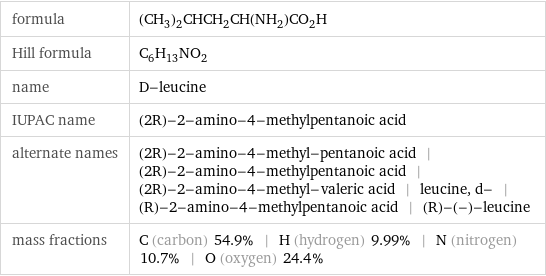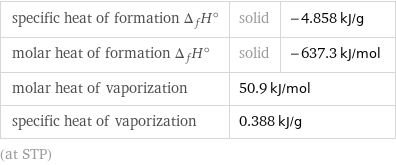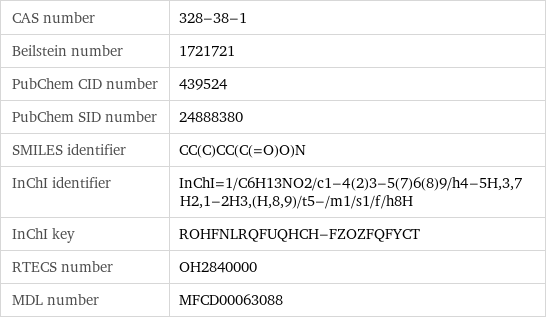Input interpretation

D-leucine
Chemical names and formulas

formula | (CH_3)_2CHCH_2CH(NH_2)CO_2H Hill formula | C_6H_13NO_2 name | D-leucine IUPAC name | (2R)-2-amino-4-methylpentanoic acid alternate names | (2R)-2-amino-4-methyl-pentanoic acid | (2R)-2-amino-4-methylpentanoic acid | (2R)-2-amino-4-methyl-valeric acid | leucine, d- | (R)-2-amino-4-methylpentanoic acid | (R)-(-)-leucine mass fractions | C (carbon) 54.9% | H (hydrogen) 9.99% | N (nitrogen) 10.7% | O (oxygen) 24.4%
Lewis structure

Draw the Lewis structure of D-leucine. Start by drawing the overall structure of the molecule, ignoring potential double and triple bonds: Count the total valence electrons of the carbon (n_C, val = 4), hydrogen (n_H, val = 1), nitrogen (n_N, val = 5), and oxygen (n_O, val = 6) atoms: 6 n_C, val + 13 n_H, val + n_N, val + 2 n_O, val = 54 Calculate the number of electrons needed to completely fill the valence shells for carbon (n_C, full = 8), hydrogen (n_H, full = 2), nitrogen (n_N, full = 8), and oxygen (n_O, full = 8): 6 n_C, full + 13 n_H, full + n_N, full + 2 n_O, full = 98 Subtracting these two numbers shows that 98 - 54 = 44 bonding electrons are needed. Each bond has two electrons, so in addition to the 21 bonds already present in the diagram add 1 bond. To minimize formal charge carbon wants 4 bonds and oxygen wants 2 bonds. Identify the atoms that want additional bonds and the number of electrons remaining on each atom: Fill in the 1 bond by pairing electrons between adjacent highlighted atoms: Answer: | |
3D structure

3D structure
Basic properties

molar mass | 131.17 g/mol phase | solid (at STP) melting point | 293 °C density | 1.293 g/cm^3 solubility in water | very soluble
Units

Hydrophobicity and permeability properties

predicted LogP hydrophobicity | -1.81 predicted LogS | -0.27
Basic drug properties

approval status | experimental | small molecule
Solid properties (at STP)

density | 1.293 g/cm^3 vapor pressure | 0.03 mmHg (at 25 °C)
Units

Thermodynamic properties

specific heat of formation Δ_fH° | solid | -4.858 kJ/g molar heat of formation Δ_fH° | solid | -637.3 kJ/mol molar heat of vaporization | 50.9 kJ/mol | specific heat of vaporization | 0.388 kJ/g | (at STP)
Chemical identifiers

CAS number | 328-38-1 Beilstein number | 1721721 PubChem CID number | 439524 PubChem SID number | 24888380 SMILES identifier | CC(C)CC(C(=O)O)N InChI identifier | InChI=1/C6H13NO2/c1-4(2)3-5(7)6(8)9/h4-5H, 3, 7H2, 1-2H3, (H, 8, 9)/t5-/m1/s1/f/h8H InChI key | ROHFNLRQFUQHCH-FZOZFQFYCT RTECS number | OH2840000 MDL number | MFCD00063088
Safety properties

flash point | 90 °C
Toxicity properties

odor | odorless

RTECS classes | other